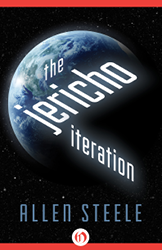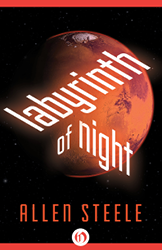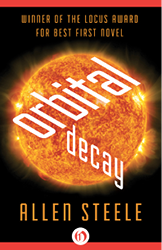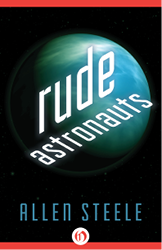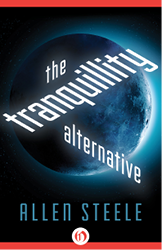Labyrinth of Night (51 page)
Read Labyrinth of Night Online
Authors: Allen Steele

The time had come to say farewell, in the only way that the Cooties had ever paid any attention.
Cassidy swallowed and touched the strings of his instrument. He played a couple of random notes, but found no inspiration. He glanced up at Arthur Johnson; his old friend waited expectantly but said nothing. The musician looked toward the computer room.
‘Excuse me,’ he said. Through the window, the other two scientists were still staring intently at the screen. ‘Excuse me,’ he said more loudly, and they looked over their shoulders at him. ‘Would y’all mind standing out of the way for a minute? I want to see what’s on that thing.’
The two men glanced at each other, then at Johnson. Arthur made a shooing gesture with his hand; the radio astronomers stood erect and stepped back from the terminal, allowing Cassidy to have a clear view of the oscillating signal-pattern from the Cootie starship.
Cassidy watched it for a moment: a rhythmic series of ups-and-downs, almost like patterns on a music scale. Like B-flat jumping up to F, then to G, and back to B-flat…
He touched the appropriate commands into the guitar’s memory, then hesitantly placed his fingers on the strings and began to play a deep-throated, melancholy song, one so old that no one knew its exact origins, yet so familiar that every seasoned musician had performed it at some time or another. He started with a thumping, repetitive bass-line, then assayed a quick run from the low end of the scale to the high, then back again…Cassidy closed his eyes as he concentrated on the opening bars, then placed his lips against the harmonica and tramped through the refrain once again, this time accompanying his guitar licks with the brassy railroad-blues sound. When he was through with the harmonica, he raised his head and sang to the aliens…
‘I know you rider.
Gonna miss me when I’m gone.
Well, I know you rider,
Gonna miss me when I’m gone.
Gonna miss you, babe,
From rolling in your arms…’
Across the room, Arthur Johnson nodded his head in time with the music; inside the META room, the two scientists turned their attention from the pulses on the screen to watch Cassidy dishing out the timeless song.
‘I’m goin’ down the road
Where I can get more decent care.
I’m goin’ down the road
Where I can get more decent care.
Goin’ back to my used-to-be rider
’Cause I don’t feel welcome here…’
Cassidy accented the second stanza with another refrain on his harmonica, a sassy comment to an extraterrestrial vessel leaving the confused realm of humanity forever. A nanosecond later it was transmitted to the asteroid belt, hurled at the speed of light toward an invisible lifeboat making its way back home across a trackless void. A last goodbye from Earth.
When Cassidy was through with the song, they waited for a reply, watching the terminal screen for a change in pattern, an alteration in the interplanetary static. A sign that they cared. None came. As before, the human race was left only with themselves for conversation.
No farewells, no promises to return. No comfort from a hard, remorseless universe. Only the memory of an old, sad tune, lost somewhere in deep space, falling through the labyrinth of night.
T
HE AUTHOR EXTENDS
his appreciation to the following persons for their assistance in the research and development of this novel: Koji Mukai, Tom Scheelings, Randy Kennedy, Phil Unger, Bob Liddil, Gardner Dozois, Sheila Williams, James Patrick Kelly, Kent Orlando, Doug Ferguson, Malcolm Hopker, Mike Nugent, Gary Freeman and Bob Eggleton. I’m also grateful for the continued support of Deborah Beale, Charon Wood, Ginjer Buchanan, Susan Allison, Carol Lowe, Martha Millard and Shelly Powers. Special thanks, as always, are also due to my wife Linda.
Most of the scientific background and technological extrapolation has been drawn from the published papers of the first three ‘Case for Mars’ conferences, held at the University of Colorado in Boulder between 1981 and 1987; much of the rest was gleaned from such diverse sources as space-science and astronomy texts, newspaper clippings and interesting plastic model kits. However, the most controversial source for this novel is its very springboard for inspiration: the so-called ‘Face’ and the nearby ‘City’ in the Cydonia region of Mars.
Most of the details of these alleged ‘alien artifacts’ were derived from two books which have been published about the subject:
The Monuments of Mars
by Richard C. Hoagland and
The Face on Mars
by Randolfo Rafael Pozos. While some of the theories and conjectures about the Cydonia anomalies have been included in this novel, others have been left out, and more than a few are completely the product of this author’s imagination.
In real life, the oddities which were photographed by the NASA
Viking
orbiters in 1976 have been either hailed as certain proof of extraterrestrial intelligence or dismissed as wild-eyed pseudo-science. The truth probably lies somewhere between the opposite poles of fact and fantasy; the verdict isn’t in yet, and perhaps won’t be conclusively delivered until the first manned expedition is made to the Cydonia region. We can only hope this happens within our lifetimes.
For the purposes of this work, the Face and the City are treated as if they do indeed exist, but this should not be misconstrued as whole-hearted endorsement of the ‘Face on Mars’ theories: the author neither claims to be a believer nor a disbeliever. This is intended as a work of science
fiction,
nothing more or less.
Your acceptance of the underlying premise, or your skepticism of the same, are both welcome.
September 1987-December 1991
Rindge, New Hampshire
Sanibel, Florida
St Louis, Missouri
Before becoming a science fiction writer, Allen Steele was a journalist for newspapers and magazines in Massachusetts, New Hampshire, Missouri, and his home state of Tennessee. But science fiction was his first love, so he eventually ditched journalism and began producing that which had made him decide to become a writer in the first place.
Since then, Steele has published eighteen novels and nearly one hundred short stories. His work has received numerous accolades, including three Hugo Awards, and has been translated worldwide, mainly into languages he can’t read. He serves on the board of advisors for the Space Frontier Foundation and is a member of the Science Fiction and Fantasy Writers of America. He also belongs to Sigma, a group of science fiction writers who frequently serve as unpaid consultants on matters regarding technology and security.
Allen Steele is a lifelong space buff, and this interest has not only influenced his writing, it has taken him to some interesting places. He has witnessed numerous space shuttle launches from Kennedy Space Center and has flown NASA’s shuttle cockpit simulator at the Johnson Space Center. In 2001, he testified before the US House of Representatives in hearings regarding the future of space exploration. He would like very much to go into orbit, and hopes that one day he’ll be able to afford to do so.
Steele lives in western Massachusetts with his wife, Linda, and a continual procession of adopted dogs. He collects vintage science fiction books and magazines, spacecraft model kits, and dreams.

Linda Steele
All rights reserved, including without limitation the right to reproduce this ebook or any portion thereof in any form or by any means, whether electronic or mechanical, now known or hereinafter invented, without the express written permission of the publisher.
This is a work of fiction. Names, characters, places, events, and incidents either are the product of the author’s imagination or are used fictitiously. Any resemblance to actual persons, living or dead, businesses, companies, events, or locales is entirely coincidental.
An earlier and substantially different version of the first part of this novel appeared in
Isaac Asimov’s Science Fiction
in September 1989
Copyright © 1992 by Allen M. Steele
Cover design by Michael Vrana
978-1-4804-3994-8
This edition published in 2013 by Open Road Integrated Media, Inc.
345 Hudson Street
New York, NY 10014


